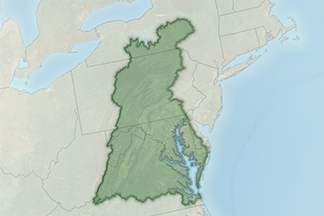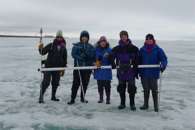Latest Features

A Celebration of Clouds: From Space, Earth Has an Elegant Atmosphere
December 20, 2016Clouds can be a nuisance when scientists are trying to observe features on Earth's surface. But at other times, clouds are exactly what they want to see. These images highlight some of the more unusual and beautiful clouds observed in recent years from space. Read more

The Chesapeake Bay Watershed: Still Cloudy, With a Chance of Clearing
December 1, 2016It is the largest estuary in the United States and third largest in the world. Once sculpted and changed by ice, water, and powerful geologic forces over tens of millions of years, today's Bay is shaped by human forces as well. Read more

EO Kids
October 18, 2016New magazine with stories just for kids. Find out where all of Earth's fresh water is and try some fun experiments. Download the first issue of NASA's newest kid's magazine, EO Kids, and Explore your Earth. Read more

Sea Level Rise Hits Home at NASA
August 26, 2015Sea level rise is not just an academic concern for NASA satellites and scientists. With two-thirds of its infrastructure and assets situated on the coast, the agency has first-hand experience with the effects of rising waters. Read more
2016
Notes from the Field: Beaufort Gyre Exploration Project 2016
October 13, 2016This annual expedition is enabling scientists to better understand the freshwater balance of the Arctic Ocean. Timed in late summer to coincide with the Arctic sea ice minimum, the campaign provides scientists with an opportunity to deploy a suite of oceanographic instruments within this harsh and remote environment. Read more
Sea Ice
September 16, 2016Polar sea ice grows and shrinks dramatically each year, driven by seasonal cycles. Habitat for wildlife and harbinger of changing climate, sea ice offers scientists important clues about the state of our planet. Read more
Notes from the Field: Observations of Aerosols Above Clouds and their Interactions (ORACLES)
September 6, 2016Off the coast of Namibia in southern Africa, a near-permanent cloud-bank and a layer of airborne particles above it make the perfect natural laboratory to study the interactions of clouds, aerosols, and climate change. Read more
A Tale of Fire and Water: A NASA Scientist's Quest to Understand the Rain in Africa
August 25, 2016Charles Ichoku wants to understand whether fires in sub-Saharan Africa are changing the timing and duration of rains. The viability of Lake Chad may depend on what his team finds. Read more
National Parks from Space
August 22, 2016The U.S. National Park Service celebrates its centennial in 2016, commemorating 100 years of stewardship of America’s natural and historic treasures. Many of those monuments, scenic rivers, parks, and historic sites are visible from space—where the views are just as compelling. Read more
Notes from the Field: Salinity Processes in the Upper Ocean Regional Study (SPURS)
August 10, 2016In the second part of this field campaign, scientists will visit the Pacific Ocean southwest of Hawaii where ocean salinity concentrations are driven by precipitation. They will spend six weeks studying how variations in salinity relate to an acceleration of the global water cycle and climate change. Read more
Notes from the Field: ATom 2016: World Survey of the Atmosphere
August 2, 2016The Atmospheric Tomography (ATom) mission seeks to understand how short-lived greenhouse gases like ozone and methane contribute to climate change. NASA's DC-8 flying laboratory will fly from Alaska to the tip of South America, then north to Greenland to measure more than 200 gases and particles in the air and their interactions. Read more
Notes from the Field: The Ablation Zone: Where Ice Goes to Die
July 20, 2016In summer 2016, researchers landed on the Greenland Ice Sheet to study the efficiency of its drainage system. Intensive mapping, monitoring, and measuring of the ice sheet's rivers will help scientists improve estimates of ice loss via surface melt and its effect on global sea level rise. Read more
World of Change: Ice Loss in Glacier National Park
June 14, 2016Shrinking since at least the early 1900s, the ice cover in Glacier National Park is expected to keep declining until only insignificant lumps remain. These images show changes to the park's ice and surrounding landscape since 1984. Read more
Notes from the Field: A Satellite Scientist Visits the Ice, Alaska 2016
May 26, 2016NASA's Walt Meir uses satellites to study sea ice. But like many modelers and remote sensing researchers, he had never stepped foot on this remote polar icescape. In spring 2016, Meir joined other satellite remote sensing scientists, sea ice modelers, and field researchers in Barrow, Alaska. Read more
Natural Beauty at Risk: Preparing for Climate Change in National Parks
May 12, 2016Many National Parks were created to protect forests and ecosystems from development and fragmentation. But changes in temperature, rainfall, and atmospheric concentrations of carbon dioxide could eventually do as much to remake forests as humans did with saws and fires and bulldozers. Read more
Celebrating a Decade of CloudSat and Calipso
April 28, 2016For a decade, the CloudSat and CALIPSO satellites have used radar and lidar to “slice” through clouds and plumes of atmospheric particles to gain a better understanding of the vertical structures of the ephemeral features. Read more
Methane Matters
March 8, 2016The concentration of methane in the atmosphere has been fluctuating, mostly rising. The question is why. Scientists wonder if they have the right monitoring systems in place to answer that question adequately. Read more
Notes from the Field: Arctic-Boreal Vulnerability Experiment (ABoVE)
February 18, 2016The Arctic Boreal Vulnerability Experiment (ABoVE) is a multi-year field campaign in Alaska and western Canada, involving dozens of research teams. ABoVE researchers are investigating the vulnerability and resilience of ecosystems (such as permafrost, forests, and coastlines) and society to this changing environment. Read more
Browse Topics
World of Change
Satellite images showing how our world— forests, oceans,
cities, even the Sun— has changed in recent decades.
Read more
Blue Marble
Composite satellite images of the entire Earth.
Read more
Earth at Night
The night side of Earth twinkles with light in these composite global and regional views.
Read more
Experiments
Hands-on educational activities.
Read more
Visible Earth
A catalog of NASA images and animations of our home planet.
Read more
NASA Earth Observations
View, download, and analyze imagery of Earth science data.
Read more













